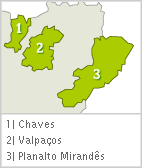In the far north east of Portugal, north of the Douro region, one finds the wine region of Trás-os-Montes, which is divided into three sub-regions: Chaves, Valpaços and Planalto Mirandês.
 The name Trás-os-Montes (something like: “behind the hills”) refers to the region’s location: beyond the Marão and Alvão mountain ranges, north of the river Douro. It is an area of mountains and granite soils.
The name Trás-os-Montes (something like: “behind the hills”) refers to the region’s location: beyond the Marão and Alvão mountain ranges, north of the river Douro. It is an area of mountains and granite soils.
The climate is dry and very hot in summer, but temperatures go below 0ºC in winter.
In the sub-region of Chaves the vine is planted on slopes of small valleys crossed by the affluents of the river Tâmega. The sub-region of Valpaços, rich in water resources, is situated on a tableland. Viticulture in the area of the Planalto Mirandês suffers the influence of the river Douro.
| Historic vines |
| In Trás-os-Montes, vine growing is secular. There are references that show wine was produced during the roman occupation of the area. These wines were known for their great quality. |
| Beyond wine |
| The region of Trás-os-Montes is also famous for its medicinal waters. |
|
1
2


|
|
The grape varieties planted are common to the three sub-regions. The most planted reds are Trincadeira, Bastardo, Tinta Roriz, Touriga Nacional and Touriga Franca. The most important whites are Síria, Fernão Pires, Gouveio, Malvasia Fina, Rabigato and Viosinho.
This region’s red wines are usually fruity and slightly astringent. White wines are soft, with a floral aroma.